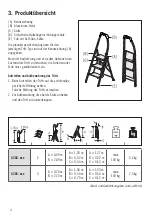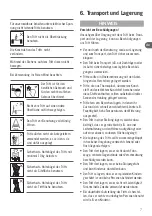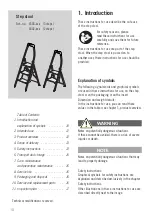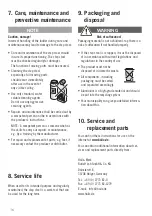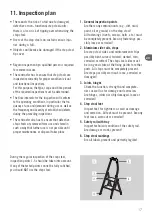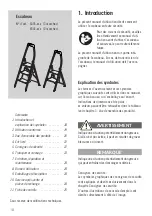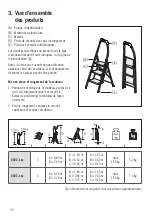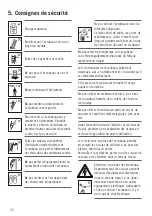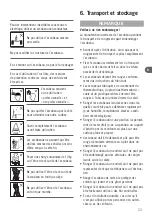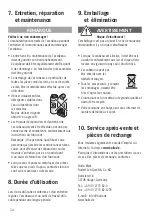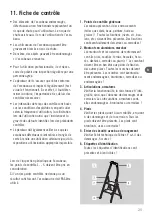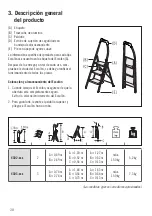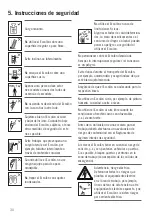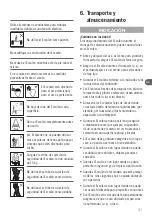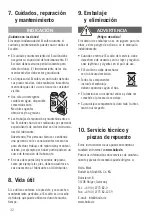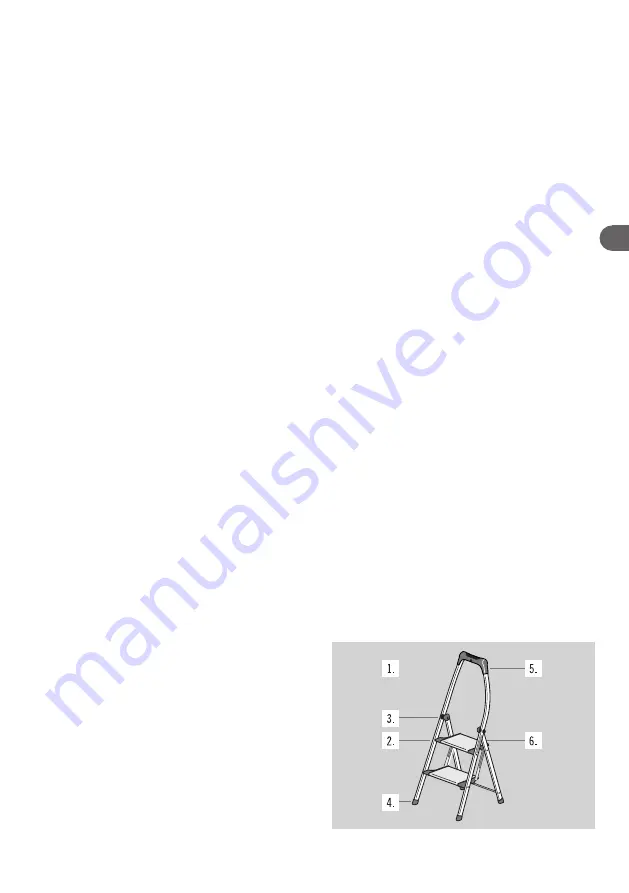
17
en
1. General inspection points
Are there any contaminants (e.g., dirt, mud,
paint, oil or grease) on the step stool?
All fastenings (rivets, screws, bolts, etc.) must
be completely present. Are any fastenings pos-
sibly loose or corroded?
2. Aluminium side rails, steps
Are step stool sides and reinforcement strips
possibly bent, curved, twisted, dented, torn,
corroded or rotten? The step stool sides must
be in a good state at the fixing points for other
parts. All steps must be completely present.
Are steps possibly worn out, loose, corroded or
damaged?
3. Joints, hinges
Check the function, strength and complete-
ness as well as for damage and corrosion.
Are hinges, joints possibly damaged, loose or
corroded?
4. Step stool feet
Inspect feet for tightness as well as damage
and corrosion. All feet must be present. Are any
feet loose, worn out or corroded?
5. Safety rail with tray
Inspect technical condition of the safety rail.
Are damage or cracks present?
6. Step stool markings
Are all labels present and perfectly legible?
• Regular inspection by a qualified person is required
for commercial use.
• The contractor has to ensure that step stools are
inspected recurrently for proper condition (visual
and functional inspection).
For this purpose, the type, scope and time periods
of the required inspections must be determined.
• The time intervals for the inspection will conform
to the operating conditions, in particular the fre-
quency of use and demands during use as well as
the frequency and severity of established defects
during the preceding inspections.
• The contractor also has to ensure that defective
step stools are removed from use and stored in
such a way that further use is not possible until
proper maintenance or disposal takes place.
• There exists the risk of a fall due to damaged,
defective or non- functional step stool units;
there is also a risk of tipping over when using the
step stool.
• Users of the step stool can sustain serious inju-
ries during a fall.
• Objects can likewise be damaged if the step stool
tips over.
During the regular inspection of the step stool,
inspection points 1-6 should be taken into account.
If any of the tested points cannot be fully satisfied,
you should NOT use the step stool.
11. Inspection plan
Summary of Contents for K100 TopLine
Page 74: ...74 1 2 3 4 5 6 7 8 9 10 11 e 74 75 76 77 77 79 80 80 80 80 81 76 1 4303 xxx 3 4302 xxx 2...
Page 75: ...75 ru A B A B C e A B C EN 14183 150 2...
Page 77: ...77 ru 1 1 5 4...
Page 78: ...78 5...
Page 79: ...79 ru 6 10...
Page 81: ...81 1 2 3 4 5 6 1 6 11 ru...
Page 82: ...82 84 4 5 1 1 2 3 4 5 6 7 8 9 10 11 82 83 84 85 85 87 88 88 88 88 89 4303 xxx 3 4302 xxx 2...
Page 83: ...83 ja A B A B C A B C EN 14183 150 kg 2...
Page 85: ...85 ja 5 4 1 x 1 x...
Page 86: ...86 5...
Page 87: ...87 10kg ja 6...
Page 89: ...89 ja 1 2 3 4 5 6 1 6 11...
Page 90: ...90...
Page 91: ...91...


